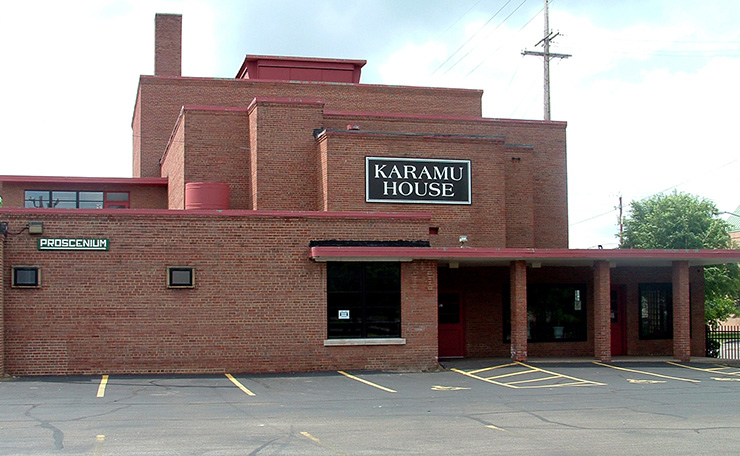Cleveland – Karamu House Theater
Historic Theaters
CASE Studies

Current Name of Theater: Karamu House
Current Type: Performing Arts Theater
Seats: ? Area: 74,050 ft²
Website: www.karamuhouse.org
Historic Names of Theater: Settlement House
Address: 2355 E 89th St, Cleveland, OH 44106
Contact: (216) 795-7070
Email: info@karamuhouse.org
Year Built/Style: 1915 / Modern architecture, Streamline Moderne
Original Architect:
Original Cost:
Listed on National Register: yes 82001368 – December 17, 1982
History of Theater:
In 1915, Russell and Rowena Woodham Jelliffe, graduates of Oberlin College in nearby Oberlin, Ohio, founded what was then called The Neighborhood Assn. at 2239 E. 38th St. establishing it as a place where people of all races, creeds and religions could find common ground. The Jelliffes discovered in their early years, that the arts provided the perfect common ground, and in 1917 plays at the “Playhouse Settlement” began.
The early twenties saw a large number of African Americans move into an area in Cleveland, from the Southern United States. Resisting pressure to exclude their new neighbors, the Jelliffes insisted that all races were welcome. They used the United States Constitution; “all men are created equal”. What was then called the Playhouse Settlement quickly became a magnet for some of the best African American artists of the day. Actors, dancers, print makers and writers all found a place where they could practice their crafts. Karamu was also a contributor to the Harlem Renaissance, and Langston Hughes roamed the halls constantly.
Reflecting the strength of the Black influence on its development, the Playhouse Settlement was officially renamed Karamu House in 1941. Karamu is a word in the Kiswahili language meaning “a place of joyful gathering”. It is a place where families could gather, share stories, feast, and enjoy. Karamu has a tradition of allowing the audience to meet, and greet actors in a reception line, the “gathering place” extends itself into the community through such face to face encounters.
The original Drama/Theatre for Youth (DT/Y), now called “TOPS” was modeled after a Colorado program, under the direction of Jeff Gruszewski. DT/Y was formed in 1987, and toured to hundreds of schools in Cuyahoga, Summit, Elyria, Erie, and Lorain counties. The original company consisted of Abdullah Bey, Susan Benson, Renee Matthews-Jackson, David Reichhold, and Jerry Urick. From 1987 to present day, there have been 23 different ensemble tour companies.
Karamu House had developed a reputation for nurturing black actors having carried on the mission of the Gilpin Players, a black acting troupe whose heyday predated Karamu. Directors such as John Kenley, of the Kenley Players, and John Price, of Musicarnival — a music “tent”[clarification needed] theater located in Warrensville Heights, Ohio, a Cleveland suburb — recruited black actors for their professional productions.,
In 1931, Langston Hughes, and Zora Neale Hurston were negotiating with the Jelliffes to produce ‘Mule Bone’, their two act collaboration, when the two writers “fell out”. A series of conversations between the Hughes and Hurston estates, the Ethel Barrymore Theatre presented the world premiere of Mule Bone on Broadway in 1991. Finally, sixty-five years after the production was originally proposed, Karamu House presented Mule Bone (The Bone Of Contention) as the 1996-1997 season finale. Karamu’s production, directed by Sarah May, played to standing room only audiences in the Proscenium (Jelliffe) Theatre. The by-line in The Plain Dealer, as the Cleveland theatre season came to its end read: “Karamu returns to Harlem Renaissance status”. Critic Marianne Evett shared Karamu’s success story as the theatre began to recover from past hardships. The revival Karamu House needed so desperately had arrived. During this time, playwright and two time Emmy nominee Margaret Ford-Taylor held the position of Executive Director, and Sarah May, Artistic Director.
Since October 2003, Terrence Spivey has served as Karamu’s artistic director.
Cost of Rehabilitation:
Architect:
Contractors:
Source of Funds:
Renovation Story:
Karamu offers art experiences for people of all ages through a variety of programs. The three primary program areas are the Early Childhood Development Center, the Center of Arts and Education, and the Karamu Performing Arts Theatre.
Sharon Williford (actress/singer) was groomed by Karamu. She appeared in Singin’ and Shoutin’ (Mike Malone), First Breeze of Summer (Leslie Lee) and In the Wine Time (1987) Don Evans.
![]()

